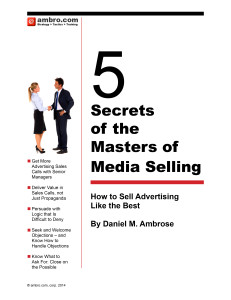I have been advising and training digital publishers on how to sell advertising for 20 years. After a career in selling print advertising, first I predominately worked with digital publishers. Then, after the internet advertising industry was off and running, I was most often hired by print-advertising, sales-driven publishers to teach their sales people how to sell digital. Now, digital advertising has so much momentum that people have begun to wonder whether print is dying.
The lasting values of print are being recognized. The permanence of print is one value and the natural “browsing” way people scan through a newspaper or magazine and discover editorial and advertising that they didn’t go looking for is another. That is often called serendipity. Planned serendipity is an important part of a media plan to communicate with new prospective customers.
Neither value is replaced by a digital solution on the market today. Another lasting value of print is that it literally demands attention, while so many digital messaging solutions are easy to miss; they either go by without being seen or are, like email, easy to delete. But print, when it arrives in your home or office, demands to be addressed.
Recently, I wrote two posts on how young people relate to print vs. digital media. They like and use books and remember print content better than digital, based on an academic study of the effectiveness of university alumni magazines.
 Now my attention is called to print’s value in demanding attention when I read James Fallows’ interview with renowned efficiency guru David Allen in October 2012 at The Atlantic.
Now my attention is called to print’s value in demanding attention when I read James Fallows’ interview with renowned efficiency guru David Allen in October 2012 at The Atlantic.
The problem with all this digital stuff is “out of sight, out of mind.” That’s the bad news about the computer and why low-tech is oftentimes better–because it’s in your face. I know quite a number of people, high-tech people, who have gone back to paper-based planners and lists because it’s much more evident, and it doesn’t sort of go away and you [don’t] go numb to it, which you can very easily do on the computer. You have to have a high level of GTD discipline and knowledge-worker discipline to get yourself to go back in your computer and make sure none of that stuff is lying fallow for any length of time.
Advertisers who want to build brand reputation, trust, and a sense of permanence for their company will do well to have a portion of their media budget going into print where the publication and the advertising really does perform a valuable function “because it’s in your face.”
Advertising sales people who want to sell more print advertising will be well serviced by explaining well to their customers the role that print plays in the path to purchase.


Pingback: What You Can Learn From Techies: How to Sell Print | ambro.com